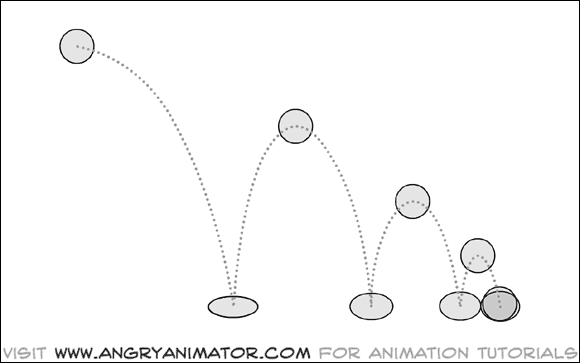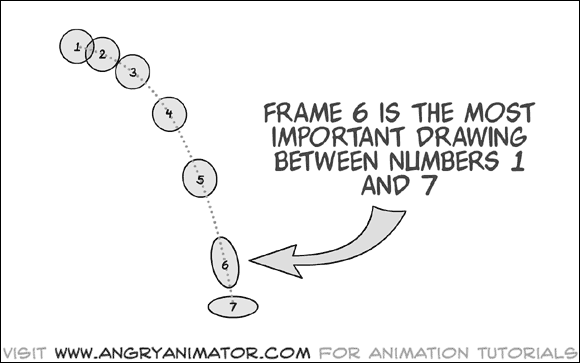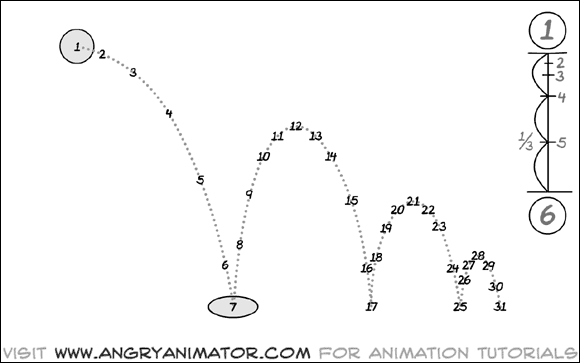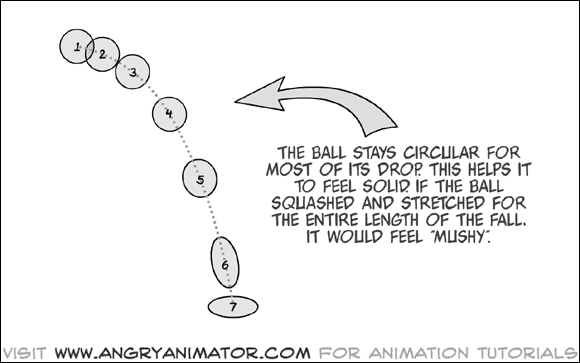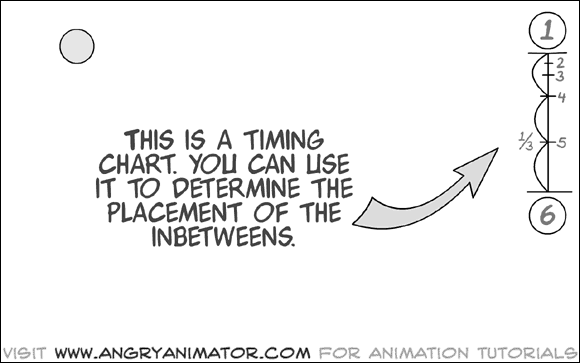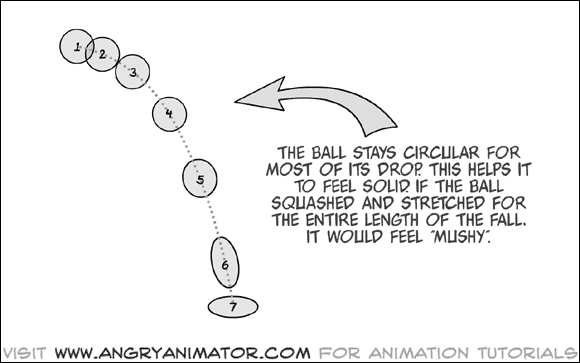Week 3:
WARM UP
CUBES & CYLINDERS- 6 Minutes
Build simple three-dimensional shapes out of lines and ellipses. Y
You can lay them on to the perspective grid or they can be free floating.
Notice: What kinds of forms are you making? When lumped together do they express another later form?

The Bouncing Ball
This exercise (below adapted from the angry animator) will teach you the most important principles of animation, namely:
Arcs.
Timing/Spacing.
Squash and Stretch.
Volume.
This is the first lesson taught to any animation student. It may seem boring, but by following it you will grasp most of the principals used in animation. Study the bouncing ball scene above: Look at it again with all the frames superimposed.
Now some of the techniques used become easier to see.
1. Arcs. The ball falls in an elliptical arc through space. Most things move in an arc of some kind. If the ball were to move in a straight line between the high and low points of the bounce, then the action would look very unnatural.
2. Timing. (or Spacing). As the ball falls it is accelerated by gravity, the gap between each frame growing all the time until the ball contacts the ground. As the ball bounces from the ground the opposite happens: as the ball hops up it moves very fast at first, then slows down by gravity into the high piont of its bounce. Note that at the high point of the bounce the ball is weightless…perfectly balanced between the force of gravity pulling it down, and its own momentum moving it forward.
3. Squash and Stretch. As the ball falls it stretches. When it impacts the ground it squashes. When it bounces off the ground it stretches again. Note how quickly the ball regains its circular shape. Too much squash and stretch can make an object look “mushy”.
4. Volume. The ball should remain the same mass as it squashes and stretches. If the ball were to squash too much it would seem to be growing physically bigger. This is very eye catching, and looks weird.
How to animate the ball. The process of animating the ball is straightforward. On a single sheet of paper, draw the arc path that the ball will follow.
On this drawing, tick off the position of each ball on the arc path with an X. Be sure to number them. In feature and tv animation, frames are usually numbered 1,3,5,7,9 and so on. To simplify things here, let’s number them 1,2,3,4, etc. For an explanation of why odd numbers are used in animation, see the appendix at the bottom of the page. It’s really boring, and should be a really nice cure for insomnia.
If you have a backlight, then switch it on. Put a clean sheet over the arc path drawing. Now you are ready to begin drawing the “Key” drawings of the animation: the points where the ball is at its most extreme. In this example, its highest and lowest points in the bounce.As you can see, frame 1 is the first and highest point in the sequence. It is therefore an extreme drawing. Frame 7 is the squash drawing where the ball hits the ground. It is also an extreme, as are drawings 12,17,21,25,28 and 31.
For hand drawn:
On seperate sheets of paper, you should draw the different key frames as named above. If done correctly you should have a series of drawing numbered 1,7,12,17,21,25,28 and 31.Be sure that you write the frame numbers on the top right and bottom right of each drawing. If your drawing is a key frame (as these are) then put a circle around the number.
Place them on the peg bar with the lower numbers on the bottom and the higher numbers on the top. Now you are ready to “roll” the drawings.
How to Roll the drawings:A lot of people working in animation seem to forget how tricky this is. It is a fairly easy skill, it just takes a little practice. Do it slowly at first, as you progress you’ll begin to do it instinctively. There are people working in the industry who aren’t smart enough to chew gum and fart at the same time, and they can do it. So don’t worry. It takes a little time, but you’ll get the hang of it.
Back to the ball: Now you must add the inbetween frames. These are the drawings that go between the keys in order to make the action look smooth. It’s common for these to be called “tweens”, thanks to digital animation programs – but traditional animators call them “inbetweens” (the correct term).
All frames are equal, but some frames are more equal than others. You must determine which is the most important frame to draw next. Which has the most important action?
In this case, the most important is frame 6. It is the most stretched frame in the falling sequence. Therefore I would consider this almost as much a key frame as 1 and 7. If you have a backlight, switch it on. Put the arc path drawing on the pegs first. Then put down 1. Put down 7. Then put down a blank sheet. You should see something like this:
Now you are going to draw frame 6. Begin to sketch in the stretched ball. When stretching the ball, keep the volume consistent. The overall mass of the ball must be the same. Position it around the x drawn on the arc path. When you have finished, you will have to flip the paper to see if it moves right:
How to flip the drawings:
Flipping is similar to rolling, but whereas with rolling you move through the pages sequentially, here you move from the bottom drawing, to the top one, then to the middle one. “WHY?” you ask….because this way you can see the inbetween in motion and make subtle corrections as you work. Incredible as it seems, this method is far more accurate than a lighttable.
Watch the paper closely. Notice that both index and middle fingers are wedged between the top two layers. You begin flipping by holding up both top sheets of paper towards you. You are now looking at the lowest frame, frame 1. Then you drop the two sheets down to the board, revealing the topmost drawing, i.e. the inbetween frame. Then you lift up the top drawing to reveal the one in the middle, i.e the final keyframe. It takes time to get the hang of this. It will be well worth the effort if you do.
Now you will need to add the remaining inbetween drawings between 1 and 5. The easiestway to do this is with a timing chart.
You could “eyeball” all the remaining frames, but the surest way to do them is by writing a timing chart. It will look something like this:
The timing chart will go on frame 1, beneath the frame number on the top right of the drawing. This chart tells you that the next most important drawing is 5. That’s why it’s underlined. Note how the spacing on the timing chart relates to the spacing on the arc path above. The chart can determine the position of all the inbetween frames, and also their weight, mass, speed, etc.
Now you have keyframe 1 with a timing chart, and keyframe 6. Simply follow the chart, place the arc path on your drawing board, then 1, Then 6, and proceed to follow the timing chart. Draw 5.
Note: see how quickly the ball regained its shape…if you were to inbetween the shape as well as the position of the ball then the ball would feel very mushy…by drawing 5 as circular, the scene will be much snappier. Repeat inbetweening until the first arc of the bounce is complete. Repeat the process for all frames of the scene.
I have included all the original frames for this scene as digital files. They should print out onto regular A4 printer paper. You can print them out and peg them up onto strips of punched paper, allowing you to roll through the scene. You line them up with the crosshairs on the corners of the page. Simply paste up frame 1 as you like it, then put it on your drawing board. Then put down a strip of punched paper, and position frame 2 with its crosshairs lined up with frame 1.
IMPORTANT: all frames should be positioned against frame 1, otherwise the scene will “drift”.


